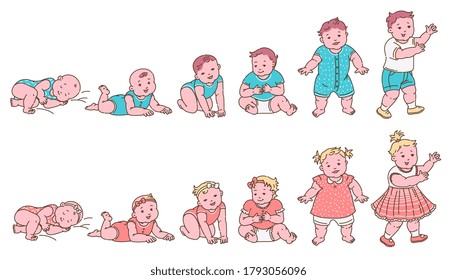Growth and Development, also known as Developmental Psychology is a branch of Psychology that studies age dynamics of the human psyche. It includes child Psychology, teenage psychology, adult psychology, and old age psychology.
Developmental Psychology
|
Developmental psychology is also known as child
development or human growth and development. It
is the study of the developmental processes involved in human physical,
emotional, social and intellectual changes from conception through
adolescence including numerous biological and cultural factors that influence
these processes. Precisely, it is the study of progressive changes in
behaviour and abilities of an individual from conception to death. However,
the study of children forms the core of developmental psychology. The journey through childhood is an interesting one
because it is the time when children’s development is manifested. The branch
of child development is gaining popularity to an extent that the knowledge
that is acquired can directly be applied to children’s lives in order to
improve their adaptation, general wellbeing, health and education. This unit
is basically meant for the would-be trained teachers who actually need this
knowledge of child’s development in order to satisfy their educational needs. It goes without saying that responsibility for
children is part and parcel of most teachers. Thorough knowledge about
children makes it easier to deal with them. Nevertheless, to understand how
children transform into adults through adolescence and the forces that aid this
transformation form the basis of developmental psychology. These
transformations or changes include growth in size, weight, ability to crawl,
stand, walk, run, read, write and perceive space. Some of the forces that
influence these changes will be covered under specific theories. |
2.1 DEFINITION OF GROWTH AND DEVELOPMENT
Growth is the progressive increase in the size of a
child or parts of a child. Growth refers to quantitative changes in an organism.
This usually involves permanent increase in size and structure of organisms.
These quantitative changes are both physical and mental. These include physical
changes in height, weight, girth, internal organs and mental changes in memory,
reasoning, perception and creative imagination.
All these
changes make the child to be physically grown and mentally responsive. The
quantitative changes in height, weight, girth etc. are as a result of multiple
cell divisions called MITOSIS (Mitotic Cell Division).
This
usually involves body cells called Somatic Cells (Vegetative cells). Somatic
cells always have 23 pairs of Chromosome (i.e. 46) called the Diploid number (2n).
In the
process of Mitosis, one cell divides into two, then into four, eight etc. Each
daughter cell is always similar in every way to the parent cell and they always
have the Diploid number (2n) of Chromosomes.
n = 23
Chromosomes
MATURATION
Maturation
is the process of gradual unfolding of the inborn potentialities of traits
present in the individual because of hereditary endowment. Maturation is the
net totality of the effects going on in a self-limited life-cycle. This implies
that maturation is the process which takes place according to the individual
differences.
Maturation
goes along with physical growth and the development of the central nervous
system. Time and experience are also inevitable. Maturation is a function of
two major factors, which are in turn dependent on time and experience that is:
(i)
Phylogenetic
Functions
These
are functions, which are common to all members of a species. These include
crawling, creeping, sitting, walking, etc.
Experience
is not necessary to these functions as they are time, age and physical and
mental maturity dependent.
(ii)
Ontogenetic
Functions
These
depend on experience. They are functions common to individuals. Some of these
functions are swimming, climbing, painting, speech, etc. Here, without
experience or training, development cannot take place.
It
should be noted that no hereditary tendency can mature fully without
environmental support i.e. environment influences development.
DEVELOPMENT
Development is progressive acquisition of various
skills (abilities) such as head support, speaking, learning, expressing the
feelings and relating with other people. Growth and development go together but
at different rates.
Child
development can be divided into a number of different aspects, for instance:
·
Physical
development: this deals with
the changes in the body
·
Personal
development: this precisely
deals with the changes in the way an individual’s personality is made up.
·
Social
development: this refers to
changes in which an individual interacts with others in society.
·
Cognitive
development: this refers to
higher mental processes such as thinking, remembering, perception, reasoning,
etc.
·
Moral
development: this refers to
changes of an individual in relation to what society expects of him or her.
THE RELATIONSHIP BETWEEN GROWTH AND DEVELOPMENT
After going through the meaning and concept of growth
and development as well as the different theories of development, now we are going
to identify the relationship between the two, which are as follows:
The term growth is used in purely physical sense. It generally refers to an increase in size, length,
height and weight. Changes in the quantitative aspects come into the domain of
growth. Development implies overall changes in shape, form or structure
resulting in improved working or functioning. It indicates the changes in the
quality or character rather than in quantitative aspects.
Growth is one of the parts of developmental process. In a strict sense, development in its quantitative
aspect is termed growth. Development is a wider and more comprehensive term. It
refers to overall changes in the individual.
Growth describes the changes which take place in
particular aspects of the body and the behaviour of an organism. Development describes the changes in the organism as
a whole and does not list the changes in parts.
Growth does not continue throughout life. It stops when maturity has been attained.
Development is a continuous process. It goes from womb to tomb. It does not end
with the attainment of maturity, the changes however small they may be,
continue throughout the life span of an individual.











0 Comments